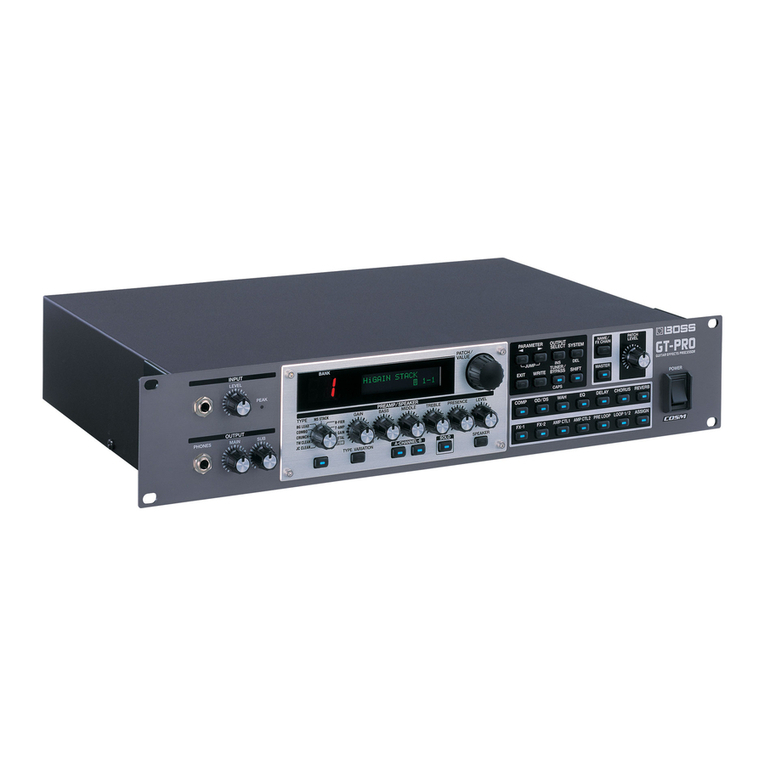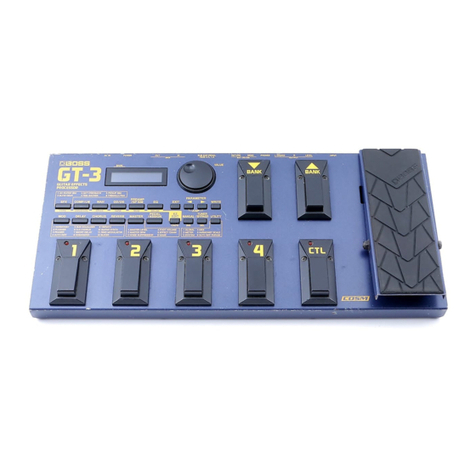BOSSCO PRO SE-70 User manual

UBOSS
SE-7
PaLeunAnenaellnneae
Ty
aneeenrmnennaancaunneneny
===
Owner's
Manual
SUPER
EFFECTS
PROCESSOR
ara
SM
RTC
eSATA
BH
HAI
s
SUPER
EFFECTS
PROCESSOR
Natue
/
“rust
se
OVERLOAD
———
a
fF
oO
an
err
EXIT
__
WRITE
WIE
on
SUPER
EFFECTS
INPUT
L-9-F
FRoOcESsor
SE=70
<4
CURSOR
P&
SPACE
ra
SKIP
——
“@PARAMETER®
UTILITY
CONTROL1

For
Nordic
Countries
Apparatus
containing
Lithium
batteries
ADVARSEL!
Lithiumbatteri
-
Eksplosionsfare
ved
fejlagtig
handtering.
Udskiftning
ma
kun
ske
med
batteri
af
samme
fabrikat
og
type.
Levér
det
brugte
baiteri
tilbage
til
leverandoren.
ADVARSEL!
Lithiumbatteri
-
Eksplosjonsfare.
Ved
utskifting
benyttes
kun
batteri
som
anbefalt
av
apparatfabrikanten.
Brukt
batteri
returneres
apparatleverandaren.
VARNING!
Explosionsfara
vid
felaktigt
batteribyte.
Anvand
samma
batterityp
eller
en
ekvivalent
typ
som
rekommenderas
av
apparattiliverkaren.
Kassera
anvant
batteri
enligt
fabrikantens
instruktion.
VAROITUS!
Paristo
voi
rajahtaa,
jos
se on
virheellisesti
asennettu.
Vaihda
paristo
ainoastaan
laitevalmistajan
suosittelemaan
lyyppiin.
Havita
kaytetty
paristo
valmistajan
ohjeiden
mukaisesti.
For
Germany
Bescheinigung
des
Herstellers
/
Importeurs
Hiermit
wird
bescheinigt,
daB
der/die/das
in
Ubereinstimmung
mit
den
Bestimmungen
der
SUPER
EFFECTS
PROCESSOR
SE-70
Amtsbi.
Vig
1046
/
1984
(Gerdt,
Typ.
Bezeichnung)
(Amtsblattverfgung)
funk-entst6rt
ist.
*
Der
Deutschen
Bundespost
wurde
das
Inverkehrbringen
dieses
Gerates
angezeigt
und
die
Berechtigung
zur
Uberpriifung
der
Serie
auf
Einhaltung
der
Bestimmungen
eingeraumt.
Roland
Corporation
Osaka
/
Japan
Name
des
Herstellersimponeaurs
For
the
USA
FEDERAL
COMMUNICATIONS
COMMISSION
RADIO
FREQUENCY
INTERFERENCE
STATEMENT
This
equipment
has
been
tested
and
found
to
comply
with
the
limits
for
a
Class
B
digital
device,
pursuant
to
Part
15
of
the
FCC
Rules.
These
limits
are
designed
to
provide
reasonable
protection
against
harmful
interference
in
a
residential
installation.
This
equipment
generates,
uses,
and
can
radiate
radio
frequency
energy
and,
if
not
installed
and
used
in
accordance
with
the
instructions,
may
cause
harmful
interference
to
radio
communications.
However,
there
is
no
guarantee
that
interference
will
not
occur
in
a
particular
installation.
If
this
equipment
does
cause
harmful
interference
to
radio
or
television
reception,
which
can
be
determined
by
turning
the
equipment
off
and
on,
the
user
is
encouraged
to
try
to
correct
the
interference
by
one
or
more
of
the
following
measures:
-
Reorient
or
relocate
the
receiving
antenna.
-
Increase
the
separation
between
the
equipment
and
receiver.
-
Connect
the
equipment
into
an
outlet
on
a
circuit
different
from
that
to
which
the
receiver
is
connected.
-
Consult
the
dealer
or
an
experienced
radio/TV
technician
for
help.
Unauthorized
changes
or
modification
to
this
system
can
void
the
users
authority
to
operate
this
equipment.
For
Canada
CLASS
B
NOTICE
This
digital
apparatus
does
not
exceed
the
Class
B
limits
for
radio
noise
emissions
set
out
in
the
Radio
Interference
Regulations
of
the
Canadian
Department
of
Communications.
CLASSE
BAVIS
Cet
appareil
numérique
ne
dépasse
pas
les
limites
de
la
classe
B
au
niveau
des
émissions
de
bruits
radioélectriques
fixés
dans
le
Réglement
des
signaux
parasites
par
le
ministére
canadien
des
Communications.
For
the
U.K.
IMPORTANT:
THE
WIRES
IN
THIS
MAINS
LEAD
ARE
COLOURED
IN
ACCORDANCE
WITH
THE
FOLLOWING
CODE.
BLUE:
NEUTRAL
BROWN:
LINE
As
the
colours
of
the
wires
in
the
mains
lead
of
this
apparatus
may
not
correspond
with
the
coloured
markings
identifying
the
terminals
in
your
plug
proceed
as
follows:
The
wire
which
is
coloured
BLUE
must
be
connected
to
the
terminal
which
is
marked
with
the
letter
N
or
coloured
BLACK.
The
wire
which
is
coloured
BROWN
must
be
connected
to
the
terminal
which
is
marked
with
the
letter
L
or
Coloured
RED.

Thank
you,
and
congratulations
on
your
choice
of
the
BOSS
SE-70
Super
Effects
Processor.
The
SE-70
is
equipped
with
a
wealth
of
high-quality
effects
perfect
for
guitars,
basses,
keyboards,
or
almost
any
other
instrument.
Additionally,
a
great
variety
of
performance
applications
can
be
enjoyed
by
using
MIDI
to
connect
the
unit
with
external
devices.
Before
starting
out,
please
take
the
time
to
read
through
this
manual.
That
way,
you
can
feel
confident
that
you
have
gained
a
grasp
of
every
feature
the
unit
provides,
and
will
enjoy
years
of
trouble-free
service.
©
Copyright
1993
by
BOSS
Corpration
All
rights
reserved.
No
part
of
this
publication
may
be
reproduced
in
any
form
without
the
written
permission
of
BOSS
CORPORATION.

FEATURES
Complete
Selection
of
Effects
The
SE-70
contains
35
effects
and
45
algorithms
(they
determine
the
way
in
which
effects
are
combined).
The
sound
quality
of
individual
effects
rival
those
of
many
professional
devices.
The
unit
is
also
unusually
versatile
as
it
can
be
used
on
almost
any
instrument,
and
in
demanding
recording
situations.
Analog
Distortion
Allows
you
to
obtain
sounds
with
a
warmth
and
fatness
that
you
normally
cannot
get
from
a
digital
device.
Vintage
Effects
Provides
effects
such
as
Slow
Gear,
Vibrato,
and
Ring
Modulator
which
have
in
recent
years
become
more
difficult
to
find.
Sampling
Capabilities
The
SE-70
is
equipped
with
its
own
sampler
capable
of
recording
up
to
2,000
ms
of
sound.
This
allows
you
to
obtain
reverse
playback
by
switching
algorithms.
It
also
means
you
can
conveniently
use
the
unit
in
ways
which
take
advantage
of
its
real-time
capabilities.
Guitar
and
Bass
Synthesis
The
SE-70
is
equipped
with
a
guitar
and
bass
synthesis
feature.
These
can
be
used
in
the
same
way
as
the
effects,
without
having
to
change
any
connections,
Tuner
A
chromatic
tuner
has
been
included
as
part
of
the
unit.
For
guitars
and
basses
it
displays
the
string
name,
and
allows
you
to
select
from
a
number
of
tuning
methods
(regular,
flat,
or
double-flat).
Metronome
The
SE-70’s
metronome
offers
a
complete
selection
of
rhythms,
including
8
beat,
16
beat,
shuffle,
and
syncopation.
Real-Time
Parameter
Control
By
using
a
foot-switch,
expression
pedal,
or
MIDI
messages,
you
can
obtain
real-time
control
over
parameters
while
you
play.
2-In/2-Out
Routing
The
SE-70
provides
for
stereo
input
and
output.
This
assures
that
the
stereo
image
of
the
original
input
will
be
maintained
even
after
effects
are
applied.
It
also
allows
you
to
process
two
separate
signals
in
parallel.
MIDI
Connectors
Since
the
SE-70
is
equipped
with
MIDI
connectors,
it
allows
you
to
send
the
effects
data
to
another
SE-70,
or
into
a
sequencer
for
storage.
Mountable
in
19-inch
Racks
Using
the
optionally
available
RAD-50
Rack
Mount
Adaptor,
the
unit
will
fit
perfect
in
a
19-inch
rack.

How
To
Use
This
Manual
This
manual
is
divided
into
three
main
sections.
Together
they
explain
the
available
functions,
and
how
they
are
used.
Also
provided
is
a
guide
to
all
the
possible
settings,
and
instructions
on
how
to
make
them.
In
addition,
an
alphabetical
index
is
provided
at
the
back,
making
it
easy
to
look
up
any
functions
or
features
you
have
trouble
understanding.
The
contents
of
each
section
are
as
follows:
SECTION
1
PROCESSING
SOUND
1
Producing
Sound
This
section
explains
how
to
connect
the
SE-70
to
your
other
equipment,
how
to
select
Patches,
and
most
of
the
other
basic
procedures
you
need
to
know.
2
Creating
Patches
The
SE-70
allows
you
to
create
your
own
Patches
by
means
of
a
few
simple
procedures.
Patches
can
then
be
stored
in
memory.
This
section
explains
how
to
do
this.
Patch:
a
collection
of
all
the
settings
necessary
to
create
a
desired
effects
program
(stored
together
in
an
easy-to—access
location).
3
Settings
This
section
provides
an
explanation
of
the
various
settings
that
allow
you
to
use
the
SE-70
in
the
way
you
require.
SECTION
2
USING
MIDI
1
About
MIDI
This
section
provides
a
basic
introduction
to
the
use
of
MIDI.
Through
MIDI,
you
will
be
able
to
use
an
external
MIDI
device
to
select
and
control
the
Patches
on
the
SE-70.
2
MIDI
Settings
Here
the
available
MIDI
features
are
explained,
along
with
instructions
on
how
to
make
settings
for
them.
3
Getting
the
Most
Out
of
the
SE-70
This
section
provides
examples
of
several
practical
applications
in
which
the
SE-70
could
be
used
while
connected
to
an
external
MIDI
device.
SECTION
3
REFERENCE
1
Reference
Here
you
will
find
information
on
what
to
do
when
your
SE-70
is
not
responding
as
expected,
along
with
other
useful
information.

FEATURES.
..........cc.csccssccsssssssessonssssssensensssennennecsosanes
4
How
to
use
This
Manudl...................0:
eee
5
TABLE
OF
CONTENTS
......0.....cscsecsessssseseesneenes
6
IMPORTANT
NOTEG................:seccesesecseeneseeetens
8
PANEL
DESCRIPTIONS.......0......o..
cc
ccceeeeesseteeee
9
1
Producing
SOUNG
...0.........
eee
12
1.
Making
the
Connections...
12
2.
Turn
On
the
POWET............ccceseesseseeeeeneeeeeeeees
13
3.
Adjusting
the
Input
Level...............-.esee
14
4.
Selecting
Patch
NUMDEIS..............
sees
14
1)
Selection
From
the
Panel
........scecssssssesseeteens
14
2)
Selection
Using
a
Foot-switch
........sseceseseeees
15
3)
Selection
Using
MIDI
Messages.......sserenseees
16
5.
Turning
Effects
On/Off............ccceeeeceeerenneees
16
1)
Switching
Using
the
Panel
........ceeseeseseseeeees
16
2)
Using
a
Foot-switch......csccseesessesereeseerseeeeeenens
16
3)
Switching
Using
MIDI
MessageS..........ssee
18
#Setting
the
Effects
OFF
Mode................s
18
2
Editing
Patches
.............sesscseeeneeenes
19
1.
First,Some
Basics
About
Patches..................
19
1)
Composition
of
Patches......sseseseseesesseseeseees
19
2)
How
to
Edit
Patches
..........:cecssceseseeesereneeeeeenes
19
2.
Copying
Patches
..........cccceeeeeressetetsenesetsees
20
3.
Editing
the
Currently
Selected
Patch...........
21
4.
Revising
the
Patch
Name...
22
5.
The
Write
Procedure...
cecereesseeteeteeees
23
3
Other
Settings...
eee
eeseesseeneees
24
1.
Using
the
Tuer
ooo...
cc
eeeseseteeeeeenreeeeeeeens
24
2.
Using
the
Metronome
............:.ssceeeerentees
28
3.
Setting
the
Mode
for
an
Effect
Remote/
Expression
29
4.
Settings
for
Control
2/3
............ccceeeeeetenees
29
5.
Adjusting
the
Display
Contrast
................-.
31
6.
Settings
for
Real-time
Control
Over
Parameters
...32
T
ABOUT
MIDI
cssisecticceceicccnssseesvsssecsaneslsteccatecher
36
1.
The
Exchange
of
MIDI
Date
............-:
cee
36
2.
MIDI
Messages
Recognized
by
the
SE-70
...37
2
MIDI
Settings
1.
Setting
the
MIDI
Channel
and
Omni
Mode
....39
2.
Changing
Pathe
............ccccseseessenseeeetsens
40
3.
MIDI
Control
(Real-Time
Control
Over
Parameters
Using
MIDI
Messages)
42
4.
Using
a
Foot
Controller(FS-50)
...............+
44
5.
Receiving
and
Sending
Date
Over
MIDI
.....45
1)
Making
the
Connections.........sseccsssereneeerens
46
2)
Setting
for
MIDI
OUt/THIU........ssseseseeeseeeeteteaes
47
3)
Date
Transmission(Bulk
Dump)
......:.:-sseeesee
47
4)
Date
Reception(Bulk
Load)
.....sseeseereeteees
48
3
Getting
the
Most
From
Your
SE-70
.......50
1)
Setup
Using
a
Keyboard
Controller
and
Sound
Module........ccccccssesseeeeseeeseeenneens
50
2)
Setup
Using
a
Guitar...
ecessssscssseeeeeesereees
51
3)
Linking
Up
With
a
Sequencel........cseesereseees
52

SECTION
3
REFERENCE
Factory
Preset
SettingS....................ccccce
54
1.
About
Factory
Preset
Settings...............0.0..
54
2.
Restoring
the
Factory
Presets
(Initializing
the
Data)
0.0...
ceeseeeereees
4
TROUBLESHOOTING.
.....00.......ccccccsessssseesesseens
56
MIDI
Implementation
Chart.......................
59
SPECIFICATIONS
....0......cecscescesseessessessesseeseessens
60
LIND
EX
a
coescactsce
ta
vearne
endian
neunnonnd
61

IMPORTANT
NOTES
Be
sure
to
use
only
the
adaptor
supplied
with
the
unit.
Use
of
any
other
power
adaptor
could
result
in
damage,
malfunction,
or
electric
shock.
[POWER
SUPPLY]
When
making
any
connections
with
other
devices,
always
turn
off
the
power
to
all
equipment
first;
this
will
help
prevent
damage
or
malfunction.
Do
not
use
this
unit
on
the
same
power
circuit
with
any
device
that
will
generate
line
noise,
such
as
a
motor
or
variable
lighting
system.
The
power
supply
required
for
this
unit
is
shown
on
its
nameplate.
Ensure
that
the
line
voltage
of
your
installation
meets
this
requirement.
Avoid
damaging
the
power
cord;
do
not
step
on
it,
place
heavy
objects
on
it
etc.
When
disconnecting
the
AC
adaptor
from
the
outlet,
grasp
the
plug
itself;
never
pull
on
the
cord.
If
the
unit
is
to
remain
unused
for
a
long
period
of
time,
unplug
the
power
cord.
[PLACEMENT]
Do
not
subject
the
unit
to
temperature
extremes
(eg.
direct
sunlight
in
an
enclosed
vehicle).
Avoid
using
or
storing
the
unit
in
dusty
or
humid
areas
or
areas
that
are
subject
to
high
vibration
levels.
Using
the
unit
near
power
amplifiers
(or
other
equipment
containing
large
transformers)
may
induce
hum.
This
unit
may
interfere
with
radio
and
television
reception.
Do
not
use
this
unit
in
the
vicinity
of
such
receivers.
[MAINTENANCE]
For
everyday
cleaning
wipe
the
unit
with
a
soft,
dry
cloth
(or
one
that
has
been
slightly
dampened
with
water).
To
remove
stubborn
dirt,
use
a
mild
neutral
detergent.
Afterwards,
be
sure
to
wipe
the
unit
thoroughly
with
a
soft,
dry
cloth.
Never
use
benzene,
thinners,
alcohol
or
solvents
of
any
kind,
to
avoid
the
risk
of
discoloration
and/or
deformation.
8
[MEMORY
BACKUP]
The
unit
contains
a
battery
which
maintains
the
contents
of
memory
while
the
main
power
is
off.
The
expected
life
of
this
battery
is
3
years
or
more.
However,
to
avoid
the
unexpected
loss
of
memory
data,
it
is
strongly
recommended
that
you
change
the
battery
every
5
years.
Please
be
aware
that
the
actual
life
of
the
battery
will
depend
on
the
physical
environment
(especially
temperature)
in
which
the
unit
is
used.
When
it
is
time
to
change
the
battery,
consult
with
qualified
service
personnel.
Please
be
aware
that
the
contents
of
memory
may
at
times
be
lost;
when
the
unit
is
sent
for
repairs
or
when
by
some
chance
a
malfunction
has
occurred.
Important
data
should
be
stored
in
another
MIDI
device
(eg.
a
sequencer),
or
written
down
on
paper.
During
repairs,
due
care
is
taken
to
avoid
the
loss
of
data.
However,
in
certain
cases,
(such
as
when
circuitry
related
to
memory
itself
is
out
of
order)
we
regret
that
it
may
be
impossible
to
restore
the
data.
[ADDITIONAL
PRECAUTIONS]
Protect
the
unit
from
strong
impact.
Do
not
allow
objects
or
liquids
of
any
kind
to
penetrate
the
unit.
In
the
event
of
such
an
occurrence,
discontinue
use
immediately.
Contact
qualified
service
personnel
as
soon
as
possible.
Never
strike
or
apply
strong
pressure
to
the
display.
Before
using
the
unit
in
a
foreign
country,
consult
with
qualified
service
personnel.

PANEL
DESCRIPTIONS
SE
<Front
Panel>
:
INPUT
Level
Knobs
L/R
i
EFFECT
On/Off
Indicator
i
Provide
adjustment
of
the
input
level.
The
adjustment
can
:
j
Lights
when
effects
are on.
}
be
made
independently
for
left
and
right
channels
(P.14).
|
OVERLOAD
Indicators
L/R
:
!
EXIT
Button
i
:
Light
when
the
input
signal
level
is
excessive
(P.14).
i
:
Pressed
to
finish
with
the
making
of
|
Posse
iatteetecheh
esate
ae
eeoerarerase
arcer
geen
eet
i
z
“
settings
for
parameters
and
return
to
i
:
—
}
the
performance made.
;
|
CONTROL
Knob
OT)
.geeeee
ei
tters
yes
to
ie
en
Numbers,
turn
se
i
a
;
WRITE
Button
ie
ee
Al
a
aah
4
ae
ae.
He
Meer
Oe
:
i
H
}
Pressed
to
store
changes
:
a
eee
pe
ak
A
pot
you
have
made
into
|
|
SE-70
super
eFrects
Processor
munsnyerer
tI
Beoes
i
oven
j
Biba
VALUE
_[
{PUSH
H
H
PRO
Ae
Eire
bree
)
Saat
\
|
|
[SUPER
EFFECTS
NPUTLOR
|
[PROCESSOR
SE=70
(C)
|
4PARAMETERP
UTILITY
CONTROL!
iy
a
“<7
CURSOR!
>
SPACE
[PHONES
Jack
=
tC
|
POWER
Switch
i
Turns
the
power
on
}
Rives:
ay
eeneee.
4
;
Accepts
connection
of
headphones.
i
i
i
i
ieee
bes
H
H H
:
i
and
off
(P.13).
b
«
spcsstbdbeuda
suasbenuassadesadtencddpan
evansesenieded
Picens
ins
fo
nit
i
d
;
Display
i
|
{PARAMETER
Buttons
:
Provides
a
readout
of
the
current
status
when
}
!
Used
to
select
a
parameter
when
you
}
;
making
settings,
along
with
a
full
range
of
othe
i
wish
to
change
its
value
(P.21).
i
;
information
about
the
SE-70.
lee
seneeeereseneeneenanseeeereneeeeemeeeesnaensassnreneer
ner
rnnes
an
oo
H
:
‘
i
Eat
ee
aie
CE
eGDEINS
UTE
LCAN
CET
EN
ern
rE
r]
: |
to
carry
out
real-time
control
over
|
snore
eee
nen
:
|
parameters
(P.32).
i
Each
press
of
|UTILITY|
takes
youtoadifferentmodeformakingsettings:
§
2
a
a‘_
ames
eee
TT
————
:
saa
ah
etan
a
tgsan
teeta
Lsjcccesisscsciocsentcnsonssbocend
7
i
UTILITY
Button
?
Pressed
when
wishing
to
make
settings
{
‘
!
:
for
parameters
that
do
not
directly
affect
Tuner
Mode
(P.24)
Metronome
Made
(P.28)
?
the
SE-70’
s
sounds
.
MIDI
Settings
With
each
press
of
[PARAMETER]
you
move
through
a
selection
of
the
modes
where
these
settings
are
made:
Omni
On/Off
(P.39)
Effect
Remote/Exp
Pedal
jack
(P.29)
|
NP
RBERIASRN
ARRAN
SORA
OIRI
BERR
ERISDENRESIETESHIL
REARS
en
ARENAS

i
MIDI
OUT/THRU
Connector
|
:
OUTPUT
Jacks
L(MONO)/R
j
Provides
output
of
MIDI
data
(P.47).
i
Provide
output
i
the
audio
signals.
Connect
with
an
amp
or
mixer
(P.
12).
|
|
INPUT
Jacks
MIDI
IN
Connector
acer
diotweeds.
your
guitar
or
|
Accepts
input
of
MIDI
data.
[eth
one
Re
Oe
Sate
Bite
Seal
ace
eR
AC
ADAPTOR
USE
Redeeted
BRB
EFFECT
REMOTE
CONTROL
{—OUTPUT_
poy
—weut
7
EXP
PEDAL
2/3
'
ADAPTOR
Redeeted
u
‘abies
L(
MONO)
GS)
O
“tl
oO
a
1©]
G3
:
a
©
OO
666
5
66
©
OUT/THRU_
ac
t2v
~%
[15a]
MoI
—
pee
SUPER
EFFECTS
PROCESSOR
i
MADE
IN
JAPAN
AC
ADAPTOR
Jack
|
LEVEL
Switch
|
Accepts
connection
of
the
supplied
AC
adaptor.
;
;
H
i
Provides
selection
for
the
rated
input
level
(P.
14).
|
i
spevesseeseusssnssoenereevengrsnnnerscereceenenesesrmmusauenenecancceegecgonaamassnnente
Hsssog
_seesadocceesceceeceanecenenereenenernnoresennannusseansnnnnaseeees
z
i
FFECT
REMOTE/EXP
PEDAL
Jack
i
CONTROL
2/3
Jack
i
}
This
jack
is
used
when
wishing
to
turn
effects
on/off
or
:
:
This
jack
is
used
when
wishing
to
select
}
to
obtain
real-time
control
over
parameters
(P.29).
i
i
Patches
or
obtain
real-time
control
over
}
UGA
TOURS
SS
SNIRCREE
teSUECIE
HOE
TDD
“SR
ERTE
i
parameters
via
a
foot-switch
(P.29).
Important
Note
If
you
are
using
the
unit
as
is
(ie.,
not
going
to
mount
it
using
the
optional
RAD-50
Rack
Mount
Adaptor),
be
sure
to
affix
the
supplied
rubber
feet
as
shown
in
the
illustration
below.
10

11

I
|
Producing
Sound
SESS
See
ROR
SS
After
making
the
necessary
connections
with
external
devices,
you'll
be
ready
to
listen
to
the
unit's
effects.
1.
Making
the
Connections
Make
the
connections
following
one
of
the
examples
below,
depending
on
the
application
you
have
in
mind.
*
Turn
off
the
power
to
all
devices
before
attempting
to
make
any
connections.
This
will
help
prevent
damage
or
malfunction.
Setup
using
a
mixer's
Send/Return
SE-70
super
GFFEcts
PROCESSOR
ono
SUPER
EFFECTS
PROCESSOR
SE-78
tear
TLR
monee
|
He
Power
Amp.
*
Check
the
position
of
the
Level
Switch.
It
should
match
the
level
used
by
your
mixer.
*
If
connecting
to
Send/Return,
you
need
to
set
the
Effect
Off
mode
to
“Mute”
(p.
18).
Setup
using
a
keyboard
L]
OUTPUT
|
R
Keyboard
SA
Bi
SUPER
EFFECTS
FROCESSOR
SE-70
sane,
SAPORAMETERR
UTA
conten
*
For
most
purposes,
the
Level
Switch
can
be
set
at
-20
dBm.
*
For
monaural
output,
use
the
OUTPUT
L
(MONO)
jack.
12

oe
oe
(Tew
e
a
oop
ooano
eo
6
oo]
roca
Ustotote
fleToTeTIOTS
|
SeT
sa
OQ
»
dsm
ct
eoo0oe
os
OO
[eee
eee
oo
oo
os
eee
st
|
([OOSO)
SOSTeTSTeIe|
oodk
ell
INPUT
L(MONO)
SE-70
super
errects
PROCESSOR
sagmeen
jexreer
Bee
ov
30k
on
pee
ee
EFFECTS
‘Oc
Fiesty
PupeRcer
ee
2a]
SE-76
nl
speller
ware
coven
t
a
aA
a
}
PHONE
aan
a
‘POWER
*
For
most
purposes,
the
Level
Switch
can
be
set
at
-20
dBm.
*
For
monaural
output,
use
the
OUTPUT
L
(MONO)
jack.
2.
Turn
on
the
Power
After
re-checking
all
the
connections,
turn
on
the
SE-70.
*
The
volume
on
your
amplifier
should
be
raised
only
after
the
power
on
every
connected
unit
has
been
turned
on.
With
power
on,
the
following
display
will
appear:
EaGSC
SSS
SUPER
EFFECTS
PROCESSOR
S&=70
A
few
seconds
later,
you
will
see
the
following
display.
This
screen
(the
Play
screen)
appears
whenever
you
are
in
the
mode
used
for
performance.
*
Each
time
power
is
turned
on,
the
Patch
you
used
last
will
be
selected
again.
*
Since
the
SE-70
is
equipped
with
a
circuitry
protection
feature,
it
requires
a
few
moments
after
power
up
before
it
is
ready
for
operation.
13

ee
ee
3.
Adjusting
the
Input
Level
Adjust
the
Input
Level
until
it
is
appropriate
for
the
particular
instrument
you
are
using.
(1)
Rotate
the
left
and
right
Input
Level
knobs
until
you
have
them
set
so
the
corresponding
OVERLOAD
indicators
light
only
on
the
highest
input
peaks.
*
These
indicators
light at
a
level
that
is
6
dB
below
the
clipping
point
(the
level
at
which
distortion
will
begin
to
occur).
*
Excessive
input
levels
will
result
in
a
distorted
output.
*
If
you
have
the
Level
Switch
set
at
“-20
dBm”
and
the
OVERLOAD
indicators
light
quite
frequently
even
when
you
turn
the
Input
Level
knobs
all
the
way
down
(-20
dBm),
you
should
set
the
Level
Switch
to
“+4
dBm”
instead.
4.
Selecting
Patch
Numbers
About
Patch
Numbers
There
are
145
‘locations’
in
the
SE-70
where
collections
of
settings
for
the
effects
can
be
stored.
Each
of
these
locations
contains
a
“Patch,”
and
each
one
of
them
is
assigned
a
“Patch
Number”
(1
to
145).
During
performance,
or
when
wishing
to
make
changes
in
the
settings
for
your
effects,
any
Patch
you
need
to
access
can
easily
be
selected
by
specifying
its
number.
1)
Selection
From
the
Panel
(1)
Rotate
the
CONTROL
knob.
With
each
turn
to
the
right,
the
Patch
Number
will
advance
by
one.
With
each
turn
to
the
left,
the
Patch
Number
will
decrease
by
one.
The
currently
selected
Patch
Number
is
shown
in
the
display.
11
119
St
Phaser
===
St
Phaser
--
When
rotated
clockwise...
1
—>
2
—>3
—
>>
3
1439
144
145
When
rotated
counter-clockwise...
1
—»>145
—»
144
—»
>:
—>4—>3—>2
*
While
editing
(modifying)
an
effect,
you
will
not
be
able
to
select
another
Patch
Number.
To
select
a
different
Patch
Number,
you'll
first
need
to
carry
out
the
‘Write’
procedure,
or
press
EXIT
and
return
to
the
Play
mode.
However,
if
you
press
EXIT
and
then
switch
to
a
different
Patch
Number,
you
will
lose
any
changes
you
made
in
the
Patch
you
were
editing.
14

2)
Selection
Using
a
Foot-
switch
Once
you
connect
an
optionally
available
FS-5U
foot-switch,
you
can
change
Patch
Numbers
using
the
pedal.
For
details,
see
“Settings
for
Control
2/3”
(P.29).
*
When
using
a
foot-switch,
you
cannot
move
continuously
through
the
Patch
Numbers
even
though
you
keep
the
pedal
depressed.
*
Be
sure
to
always
have
the
power
turned
OFF
whenever
you
connect
a
foot-switch.
An
unexpected
change
in
Patch
Number
could
otherwise
occur.
You
can
obtain
pedal
control
over
the
same
functions
provided
by
turning
the
CONTROL
knob
if
you
connect
two
foot-switches
as
shown.
Control
2
CONTROL
2/3
7
\
oh
as
Cord:Roland
PCS-31
(optional)
Control
3
Foot-Switch
(optional)
With
only
one
foot-switch
connected,
the
Patch
Number
can
only
be
either
increased
or
decreased
with
each
press
on
the
pedal.
CONTROL
2/3
(=~
O-—
O
>
Control
2
O
Foot-Switch
FS-5U
(optional)
*
Set
the
polarity
switch
on
the
FS-5U
to
the
setting
shown
below.
This
way,
at
the
moment
you
depress
the
pedal
you
obtain
a
change
in
the
Patch
Number.
Polarity
Switch
15

3)
Selection
Using
MIDI
Messages
MIDI
Program
Change
messages
provide
for
selection
among
(a
maximum
of)
128
different
Patches
(1
to
128).
However,
since
the
SE-70
is
capable
of
storing
more
than
128
Patches,
it
is
important
to
have
a
way
to
select
Patches
having
numbers
beyond
the
range
of
the
Program
Change
Numbers.
This
is
where
this
unit’s
Program
Change
Map
feature
becomes
useful,
since
it
allows
you
to
arbitrarily
set
up
a
correspondence
between
any
given
Program
Change
Number
and
a
Patch
Number.
The
Program
Change
Map
consists
of
a
complete
record
for
all
these
correspondences.
Program
Change
messages
sent
to
the
SE-70
can
be
used
to
select
Patches.
For
details,
refer
to
“About
MIDI”
(P.36).
5.
Turning
Effects
On/Off
Every
individual
effect
can
be
turned
on
and
off.
When
off,
all
selected
effects
will
either
be
bypassed
(sound
will
not
pass
through
the
processors),
or
no
sound
at
all
will
be
output.
*
Patch
Numbers
can
be
selected
even
when
effects
are
turned
off.
*
The
On/Off
status
of
the
effects
is
not
altered
by
any
other
procedures.
1)
Switching
Using
the
Panel
Press
the
CONTROL
knob
to
switch
the
effects
ON
or
OFF.
When
the
effects
are
ON,
the
EFFECT
ON/OFF
indicator
will
be
lit.
2)
Using
a
Foot-
switch
By
connecting
an
optional
FS-5U
or
FS-5L
foot-switch,
you
will
be
able
to
turn
the
effects
on
and
off
using
either
of
the
two
methods
below.
The
EFFECT
ON/OFF
indicator
will
light
when
the
effects
are
ON.
Method
1
Put
the
Remote/Expression
Pedal
setting
at
“Remote”
(UTILITY)
and
use
.an
optional
FS-SL
pedal
connected
to
the
EFFECT
REMOTE/EXP
PEDAL
jack
to
obtain
control.
(See
“Setting
the
Mode
for
a
Remote/Expression
Pedal,”
P.29)
EFFECT
REMOTE
/EXP
PEDAL
O—=
o>
|
Foot-Switch
FS-5L(optional)
16

SSS
SSR
Method
2
Using
“Settings
for
Real-time
Control
Over
Parameters”
(see
P.32),
set
the
Target
to
“Effect
On/Off,”
and
the
Source
to
“CONTROL
2
or
3.”
You
can
then
use
a
foot-switch
(optional
FS-5U
or
FS-5L)
to
obtain
control.
*
Depending
on
whether
you
use
an
FS-5U
or
FS-5L,
the
setting
you
need
to
make
for
the
Assign
Mode
within
the
Patch
will
be
different.
For
details,
refer
to
“Settings
for
Real-time
Control
Over
Parameters”
(P.32).
(White)
.
EE
be)
Dime]
Control
2
CONTROL
=
O
2/3
"4
\
i
7
Cord:Roland
PCS-31
(optional)
Control
3
Foot-Switch
FS-5U
(optional)
FS-5L
(optional)
*
If
using
an
FS-5L,
set
the
polarity
switch
to
the
setting
shown
below.
The
indicator
on
the
foot-switch
will
also
light
when
the
effects
are
on.
Polarity
Switch
*
Set
the
polarity
switch
on
the
FS-5U
foot-switch
to
the
setting
shown
below.
The
effects
will
then
be
turned
ON
or
OFF
each
time
you
step
on
the
pedal.
Polarity
Switch
LF

3)
Switching
Using
MIDI
Messages
MIDI
messages
sent
to
the
SE-70
by
an
external
device
can
be
used
to
switch
effects
ON/OFF.
For
details,
refer
to
“About
MIDI”
(P.36).
#
Setting
the
Effects
OFF
Mode
The
unit
provides
a
choice
of
whether
the
direct
sound
is
to
be
output,
or
no
sound
at
all
is
to
be
output
when
the
effects
are
turned
OFF.
(1)
Press
UTILITY
enough
times
to
reach
the
display
shown
below.
The
desired
setting
for
the
Effects
OFF
mode
is
selected
using
the
CONTROL
knob.
off
Mode
Cirect
Off
Mode
faite
Direct:
The
direct
sound
alone
will
be
output.
Mute:
No
sound
at
all
will
be
output.
(2)
When
completed,
press
EXIT
to
return
to
the
Play
screen.
In
normal
situations
(with
a
musical
instrument
connected)
you
should
set
the
mode
to
“Direct.”
If,
however,
you
are
using
a
setup
where
the
unit
is
connected
to
a
mixer’s
Send/Return
jacks,
it
should
be
set
to
“Mute.”
If
set
to
“Direct,”
there
will
be
a
change
in
the
balance
of
the
mixer’s
output
between
times
when
the
effects
are
ON
and
OFF.
This
is
because
even
with
the
effects
turned
OFF,
the
direct
sound
will
be
output.
18

2
Editing
Patches
The
SE-70
contains
145
preset
Patches.
This
section
shows
you
how
to
edit
these
existing
Patches
in
order
to
create
new
ones.
These
new
Patches
can
then
easily
be
stored
in
memory.
1.
First,
Some
Basics
About
Patches
1)
Composition
of
Patches
About
Preset
areas
and
User's
Areas
Of
all
the
Patch
Numbers
from
1
to
145,
numbers
101
to
145
are
in
the
Preset
Area,
where
you
are
not
permitted
to
store
any
changes.
Note,
however,
that
you
can
save
whatever
changes
you
make
to
a
Patch
from
the
Preset
Area,
as
long
as
you
write
it
to
a
location
within
the
User Area
(No.
1
to
100).
About
Algorithms
Every
Patch
is
created
based
on
“algorithms.”
An
algorithm
consists
of
settings
which
define
which
effects
are
to
be
used,
and
the
order
in
which
they
occur.
(The
effects
order
does
make
a
difference.)
By
choosing
a
specific
algorithm,
you
obtain
a
particular
set
of
effects
and
the
way
they
are
connected.
Note
that
any
unwanted
effects
included
in
an
algorithm
can
simply
be
turned
off.
Every
time
you
change
Patches,
the
algorithm
that
is
used
for
the
selected
Patch
appears
in
the
display.
i
The
currently
selected
Patch
Number
|
this
i
is
the
name
of
the
currently
|
{
appears
here
H
ry
*
Patches
in
the
Preset
Area
(101
to
145)
use,
in
order,
all
of
the
algorithms,
and
carry
settings
which
are
representative
of
how
each
algorithm
can
be
used.
2)
How
fo
Edit
Patches
(1)
Select
a
Patch
that
uses
an
algorithm
that
most
closely
creates
the
type
of
sound
you
have
in
mind
(P.14).
(2)
Copy
the
selected
Patch
to
another
storage
destination
(Patch
Number)
which
contains
a
Patch
you
do
not
need
(P.20).
If
you
do
not
need
to
keep
the
settings
for
a
User
Patch
selected
in
(1),
and
intend
to
keep
only
the
revised
edition,
this
step
is
not
necessary.
*
Patches
cannot
be
copied
to
locations
in
the
Preset
Area
(101
to
145).
19

(3)
Make
the
changes
in
the
Patch
(P.21).
For
each
effect
there
are
a
number
of
parameters
which
control
the
timbre
(quality)
of
the
resulting
sound.
To
edit
a
Patch
you
must
provide
each
of
these
parameters
with
an
appropriate
value.
*
The
available
parameters
will
vary
depending
on
the
algorithm
selected.
Even
when
working
with
effects
that
are
used
in
a
particular
algorithm,
you
cannot
select
the
parameters
belonging
to
an
effect
which
is
turned
off.
(4)
Give
the
new
Patch
a
name
(P.22).
(5)
Store
the
completed
effects
settings
in
memory
(P.23).
All
changes
made
in
settings
are
only
temporary.
They
will
revert
to
their
original
values
if
you
turn
the
power
off
or
select
a
different
Patch.
In
order
to
store
the
new
Patch
in
memory
you
must
perform
a
“Write”
operation.
For
every
algorithm,
the
following
information
is
shown
in
the
display:
1.
Parameters
related
to
each
of
the
effects.
2.
Parameters
related
to
real-time
control
of
the
parameters.
3.
Patch
name
editing
screen.
2.
Copying
Patches
20
Copies
of
Patches
can
be
made
from
the
Play
screen.
When
making
a
copy,
all
the
data
contained
at
one
Patch
location
is
copied
to
another
Patch
number.
*
You
can
never
copy
any
Patches
into
the
Preset
Area
(Patch
Numbers
101
to
145).
Should
you
attempt
to
copy
a
Patch
into
the
Preset
Area,
the
following
error
message
will
appear
in
the
display.
Preset
Ar
Canriat
dled
(1)
From
the
Play
screen,
use
the
CONTROL
knob
to
select
the
source
Patch
Number,
then
press
WRITE.
The
following
screen
will
appear:
Frater
FY
hair
too
es
111
Steres
Delay
(2)
Using
the
CONTROL
knob,
select
the
destination
Patch
Number.
Fateh
mops
to
..
Pal
Meee
ee
The
Patch
Name
appears
here
(3)
Press
WRITE
again,
and
the
source
Patch
is
copied.
*
To
cancel
the
procedure,
press
EXIT.
You
will
be
returned
to
the
Play
screen.
Table of contents
Other BOSSCO Recording Equipment manuals
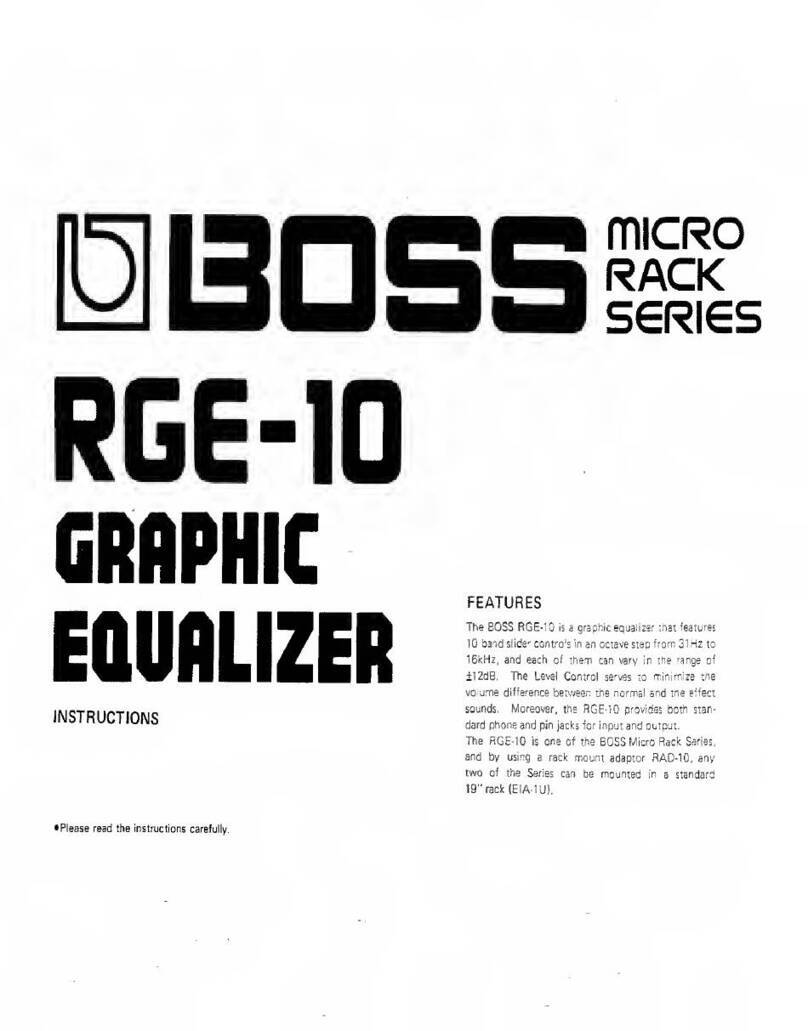
BOSSCO
BOSSCO RGE-10 User manual

BOSSCO
BOSSCO Digital Delay DE-200 User manual

BOSSCO
BOSSCO EQ-200 User manual

BOSSCO
BOSSCO SE-50 Quick start guide
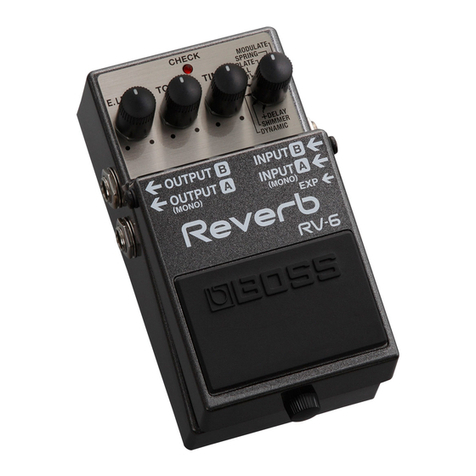
BOSSCO
BOSSCO rv-6 User manual

BOSSCO
BOSSCO GT-5 User manual

BOSSCO
BOSSCO RC-500 User manual
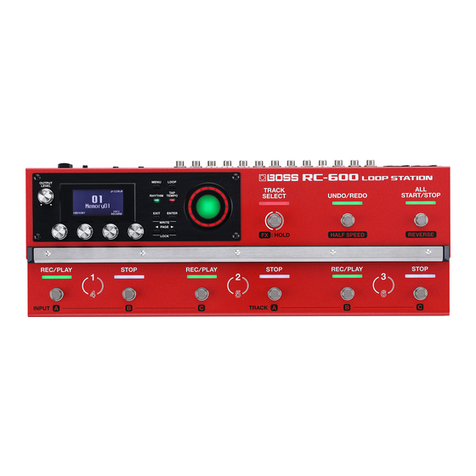
BOSSCO
BOSSCO RC-600 User manual

BOSSCO
BOSSCO ME-50 User manual

BOSSCO
BOSSCO RPS-10 User manual

BOSSCO
BOSSCO ME-20B User manual
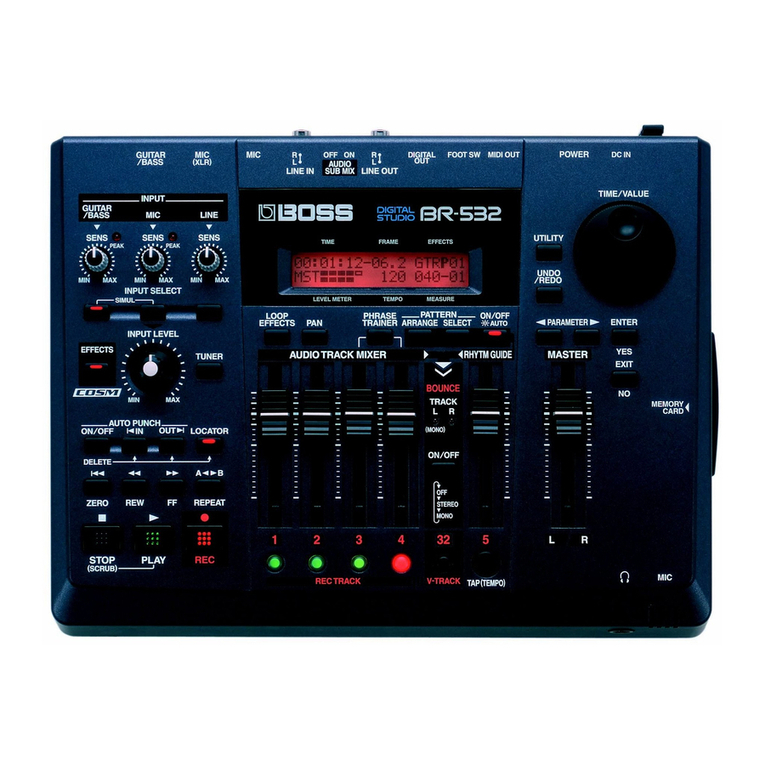
BOSSCO
BOSSCO BR-532 User manual

BOSSCO
BOSSCO RC-505 User manual

BOSSCO
BOSSCO GT-10B User manual
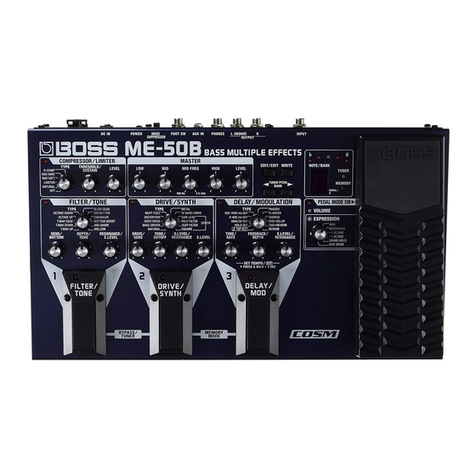
BOSSCO
BOSSCO ME-50B User manual
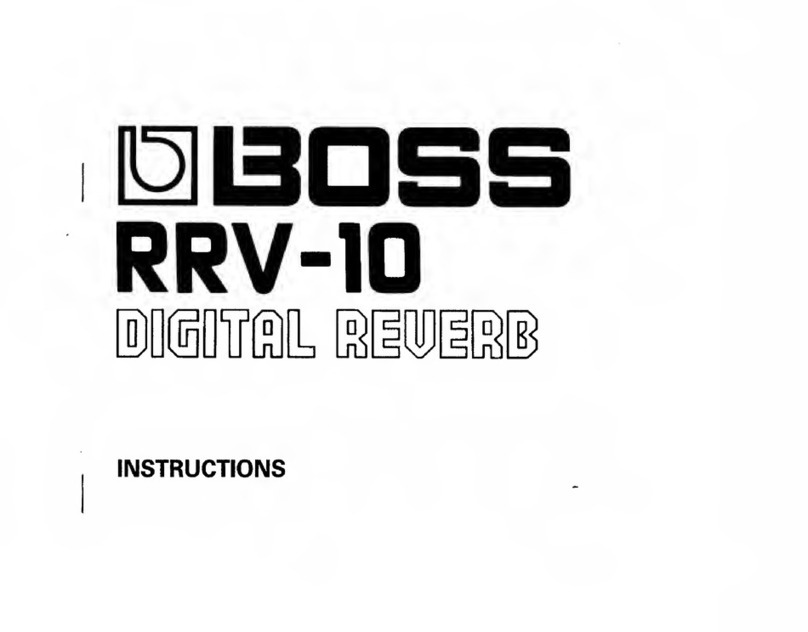
BOSSCO
BOSSCO RRV-10 User manual
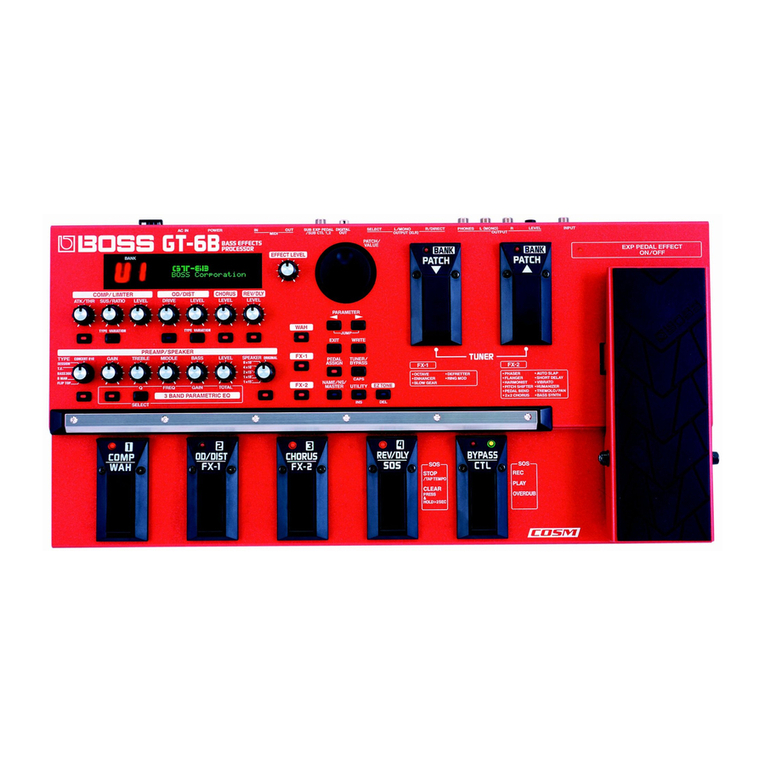
BOSSCO
BOSSCO GT-6B User manual
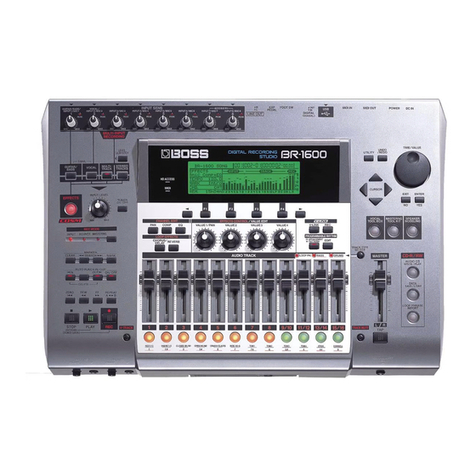
BOSSCO
BOSSCO BR-1600CD User manual

BOSSCO
BOSSCO RCL-10 User manual
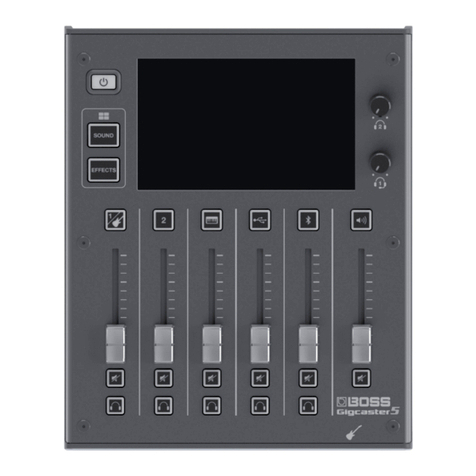
BOSSCO
BOSSCO Gigcaster 5 User guide

